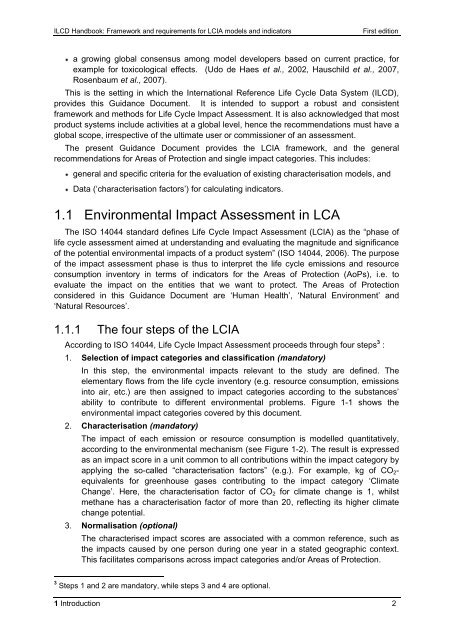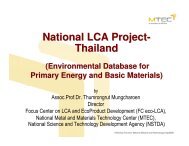ILCD Handbook: Framework and requirements for LCIA models and ...
ILCD Handbook: Framework and requirements for LCIA models and ...
ILCD Handbook: Framework and requirements for LCIA models and ...
Create successful ePaper yourself
Turn your PDF publications into a flip-book with our unique Google optimized e-Paper software.
<strong>ILCD</strong> <strong>H<strong>and</strong>book</strong>: <strong>Framework</strong> <strong>and</strong> <strong>requirements</strong> <strong>for</strong> <strong>LCIA</strong> <strong>models</strong> <strong>and</strong> indicators First edition<br />
a growing global consensus among model developers based on current practice, <strong>for</strong><br />
example <strong>for</strong> toxicological effects. (Udo de Haes et al., 2002, Hauschild et al., 2007,<br />
Rosenbaum et al., 2007).<br />
This is the setting in which the International Reference Life Cycle Data System (<strong>ILCD</strong>),<br />
provides this Guidance Document. It is intended to support a robust <strong>and</strong> consistent<br />
framework <strong>and</strong> methods <strong>for</strong> Life Cycle Impact Assessment. It is also acknowledged that most<br />
product systems include activities at a global level, hence the recommendations must have a<br />
global scope, irrespective of the ultimate user or commissioner of an assessment.<br />
The present Guidance Document provides the <strong>LCIA</strong> framework, <strong>and</strong> the general<br />
recommendations <strong>for</strong> Areas of Protection <strong>and</strong> single impact categories. This includes:<br />
general <strong>and</strong> specific criteria <strong>for</strong> the evaluation of existing characterisation <strong>models</strong>, <strong>and</strong><br />
Data (‗characterisation factors‘) <strong>for</strong> calculating indicators.<br />
1.1 Environmental Impact Assessment in LCA<br />
The ISO 14044 st<strong>and</strong>ard defines Life Cycle Impact Assessment (<strong>LCIA</strong>) as the ―phase of<br />
life cycle assessment aimed at underst<strong>and</strong>ing <strong>and</strong> evaluating the magnitude <strong>and</strong> significance<br />
of the potential environmental impacts of a product system‖ (ISO 14044, 2006). The purpose<br />
of the impact assessment phase is thus to interpret the life cycle emissions <strong>and</strong> resource<br />
consumption inventory in terms of indicators <strong>for</strong> the Areas of Protection (AoPs), i.e. to<br />
evaluate the impact on the entities that we want to protect. The Areas of Protection<br />
considered in this Guidance Document are ‗Human Health‘, ‗Natural Environment‘ <strong>and</strong><br />
‗Natural Resources‘.<br />
1.1.1 The four steps of the <strong>LCIA</strong><br />
According to ISO 14044, Life Cycle Impact Assessment proceeds through four steps 3 :<br />
1. Selection of impact categories <strong>and</strong> classification (m<strong>and</strong>atory)<br />
In this step, the environmental impacts relevant to the study are defined. The<br />
elementary flows from the life cycle inventory (e.g. resource consumption, emissions<br />
into air, etc.) are then assigned to impact categories according to the substances‘<br />
ability to contribute to different environmental problems. Figure 1-1 shows the<br />
environmental impact categories covered by this document.<br />
2. Characterisation (m<strong>and</strong>atory)<br />
The impact of each emission or resource consumption is modelled quantitatively,<br />
according to the environmental mechanism (see Figure 1-2). The result is expressed<br />
as an impact score in a unit common to all contributions within the impact category by<br />
applying the so-called ―characterisation factors‖ (e.g.). For example, kg of CO2equivalents<br />
<strong>for</strong> greenhouse gases contributing to the impact category ‗Climate<br />
Change‘. Here, the characterisation factor of CO2 <strong>for</strong> climate change is 1, whilst<br />
methane has a characterisation factor of more than 20, reflecting its higher climate<br />
change potential.<br />
3. Normalisation (optional)<br />
The characterised impact scores are associated with a common reference, such as<br />
the impacts caused by one person during one year in a stated geographic context.<br />
This facilitates comparisons across impact categories <strong>and</strong>/or Areas of Protection.<br />
3 Steps 1 <strong>and</strong> 2 are m<strong>and</strong>atory, while steps 3 <strong>and</strong> 4 are optional.<br />
1 Introduction 2



